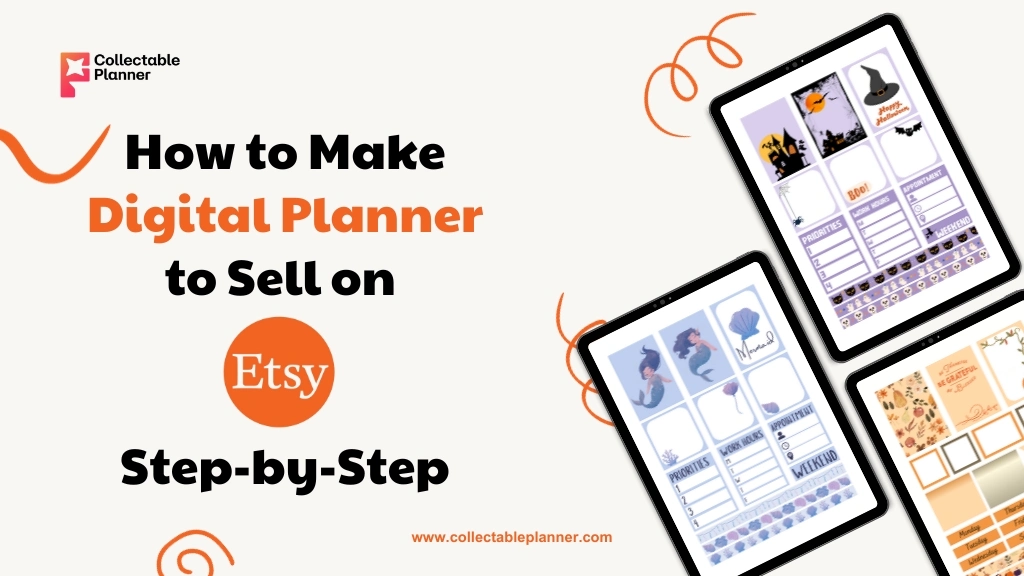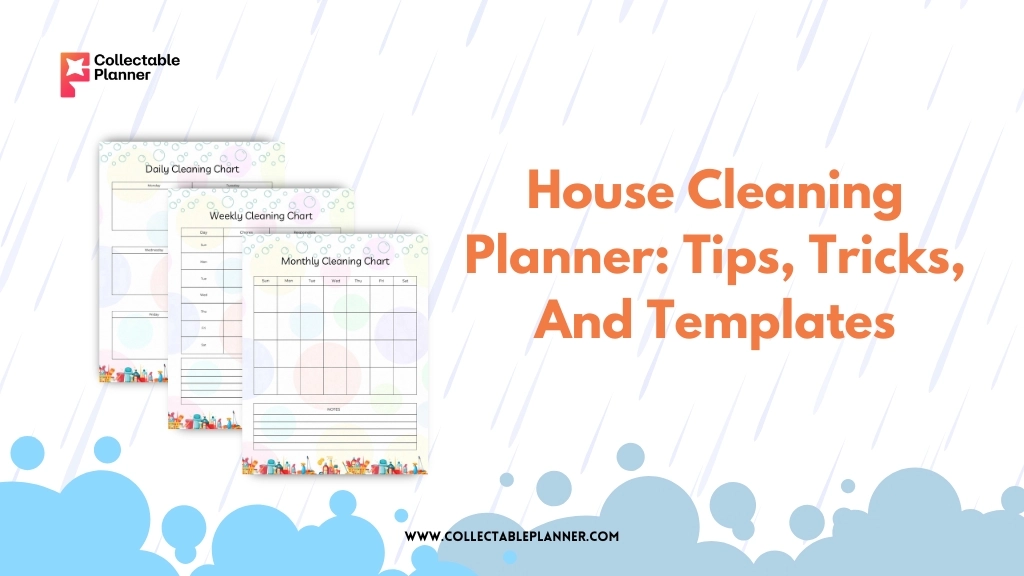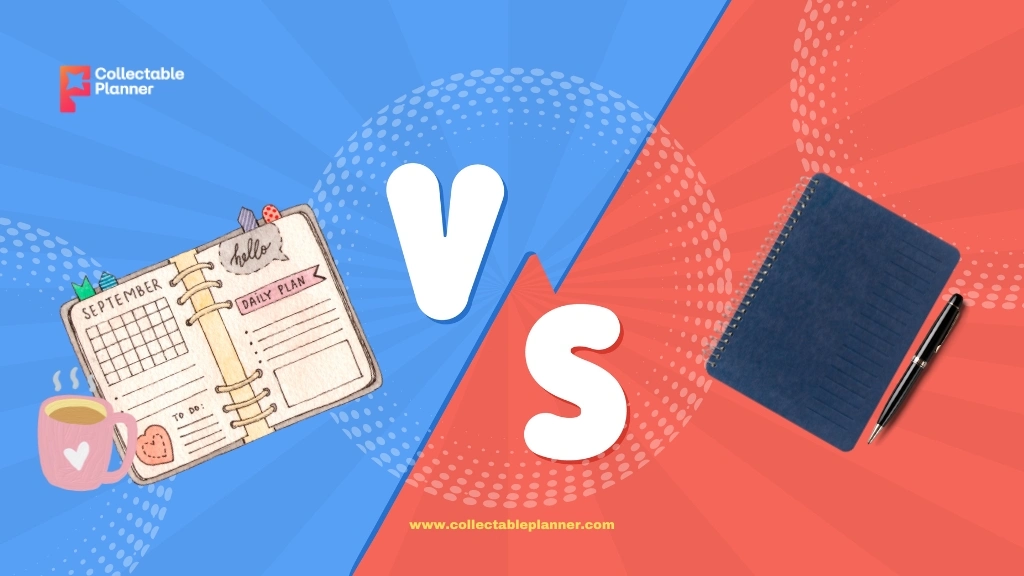Digital planners are becoming increasingly popular, as they offer a convenient and customizable way to stay organized. If you’re creative and have a knack for design, you can turn your passion into a profitable business by selling digital planners on Etsy.
In this step-by-step guide, we’ll walk you through the process of how to make a digital planner to sell on Etsy, from choosing the right platform to designing your planner with user experience in mind.
We’ll also provide bonus tips on how to price your planners, create eye-catching listings, and market your products effectively.
Benefits of selling digital planners on Etsy
There are many benefits to selling digital planners on Etsy, including:
- Low overhead costs: You don’t need to invest in inventory or shipping costs, which means you can start your business with very little money.
- Freedom to set your own prices and choose your own products: You have the flexibility to set your own prices and choose the types of digital planners that you want to create.
- Reach a global audience: Etsy has a global reach, so you can sell your digital planners to customers all over the world.
- Build a following of loyal customers: If you create high-quality digital planners, you can build a following of loyal customers who will keep coming back for more.
- Easy to start: You can create an Etsy shop and start selling digital planners in just a few minutes.
- No need to ship: Once you’ve created your digital planner, you can simply upload it to Etsy and buyers can download it instantly.
- Passive income: Once you’ve created a digital planner, you can sell it over and over again, without having to do any additional work.
How to get started
To get started selling digital planners on Etsy, you will need to:
Choose a platform – There are many different platforms that you can use to create digital planners, such as Canva, Adobe Photoshop, and GoodNotes. Choose a platform that you are comfortable using and that offers the features that you need.
Here is the step-by-step guide on How to Create a Digital Planner in Canva
Plan your content – What features will your digital planner include? What types of layouts and designs do you want to use? Consider the needs of your target audience.
Design with user experience in mind – Make sure your digital planner is easy to use and navigate. Use clear and concise labels. Choose colors and fonts that are easy to read.
Test and refine – Ask friends and family to test your digital planner and provide feedback. Make changes as needed to improve the user experience.
Export and prepare for sale – Export your digital planner in a format that is compatible with popular devices and apps – Create a listing for your digital planner on Etsy. Include clear and informative descriptions and photos.
Do your research – Before you start creating digital planners, it’s important to do your research and understand the market. What types of digital planners are popular? What are the trends? Who is your target audience?
Create high-quality products – Your digital planners should be well-designed and easy to use. Use high-quality images and fonts. Make sure your planner is free of errors.
Promote your products – Once you have created your digital planners, you need to promote them so that people can find them. Share your listings on social media, run ads, and participate in relevant online communities.
With a little effort, you can create a successful business selling digital planners on Etsy.
How to Make Digital Planner to Sell on Etsy: Step-by-Step
Step 1: Choose a platform
Choosing the right platform for creating digital planners is a crucial first step in your journey. Here are some popular platforms to consider, along with factors to help you make an informed decision:
1. Canva:
- Skill Level: Beginner to Intermediate
- Budget: Offers both free and paid subscription options.
- Pros: Canva is user-friendly and web-based, making it accessible to beginners. It provides a wide range of templates, design elements, and collaboration tools. Canva also offers a mobile app for designing on the go.
- Cons: While Canva is versatile, it may have limitations for complex and highly customized digital planners.
2. Adobe Photoshop:
- Skill Level: Intermediate to Advanced
- Budget: Requires a paid subscription to Adobe Creative Cloud.
- Pros: Photoshop is a powerful graphic design software used by professionals. It offers extensive design capabilities, making it suitable for intricate and customized digital planner designs. Photoshop allows for complete creative control.
- Cons: It has a steeper learning curve, which may be challenging for beginners. The software can be resource-intensive, requiring a capable computer.
3. GoodNotes:
- Skill Level: Beginner to Intermediate
- Budget: Requires a one-time purchase for the GoodNotes app (iOS) or a similar note-taking app for other platforms.
- Pros: GoodNotes is designed specifically for digital note-taking and planning on iPad or other tablet devices. It provides a natural handwriting experience, which is appealing to users who prefer handwritten notes and sketches.
- Cons: Limited to tablet devices with stylus support, and designs may not be as versatile as what can be created in graphic design software.
Considerations when Choosing a Platform:
Budget: Determine your budget for software or subscriptions. Some platforms offer free versions with limited features, while others require ongoing payments.
Skill Level: Assess your familiarity with graphic design software. If you’re a beginner, user-friendly platforms like Canva or GoodNotes may be a good starting point.
Design Complexity: Consider the complexity of your digital planners. If you plan to create intricate designs with many layers and custom elements, Adobe Photoshop may be better suited.
User Interface: Evaluate the user interface and tools offered by each platform. Choose one that aligns with your design preferences and workflow.
Accessibility: Ensure the chosen platform is available on your preferred device (e.g., desktop, tablet) and operating system.
Community and Support: Check if there is a supportive user community or tutorials available for the platform you choose. This can be valuable for learning and troubleshooting.
Step 2: Plan your content
When deciding on the features, layouts, and designs for your digital planner, it’s essential to consider the specific needs and preferences of your target audience. Here are some key considerations for each aspect:
Features:
Calendar Pages: Include daily, weekly, monthly, and yearly calendar pages to cater to users with varying planning needs.
Goal Setting: Incorporate goal-setting sections to help users define and track their objectives.
To-Do Lists: Provide space for users to create to-do lists, prioritize tasks, and check off completed items.
Note Pages: Include blank or lined note pages for general note-taking, brainstorming, or jotting down ideas.
Habit Trackers: Add habit tracker planner pages to assist users in forming and monitoring habits.
Financial Planning: Integrate sections for budgeting, expense tracking, and financial goal setting.
Meal Planning: Offer meal planning pages with space for menus, grocery lists, and recipe notes.
Fitness and Health: Include sections for fitness tracking, meal tracking, and health goals.
Customizable Templates: Consider providing both pre-designed templates and blank templates that users can customize to their liking.
Interactive Elements: Make your digital planner interactive by adding hyperlinks, form fields, and clickable tabs for easy navigation.
Layouts and Designs:
Clean and Minimalist: Minimalist designs with ample white space can appeal to users who prefer simplicity and a clutter-free layout.
Color-Coded Sections: Organize different sections of the planner with color-coded tabs or dividers for easy reference.
Seasonal Themes: Offer planners with seasonal themes (e.g., spring, summer, fall, winter) to cater to users who enjoy changing designs throughout the year.
Customizable Covers: Allow users to choose or customize covers that reflect their style, interests, or mood.
Illustrations and Graphics: Incorporate relevant illustrations, icons, and graphics that align with the planner’s purpose (e.g., flowers for wellness, and finance icons for budget planners).
Handwriting Fonts: Provide options for handwritten-style fonts to create a more personal touch for digital note-takers.
Professional and Corporate: Design planners with a sleek and professional aesthetic suitable for business or corporate use.
Artistic and Creative: For artistic users, consider planners with doodles, watercolor elements, or hand-drawn motifs.
Photographic: Use high-quality photographs or imagery to enhance the visual appeal of your planner pages.
Considering the Needs of Your Target Audience:
To create a successful digital planner, it’s vital to understand the specific needs and preferences of your target audience. Consider conducting surveys, seeking feedback, or researching your niche to gather insights.
For instance:
If you’re targeting busy professionals, focus on productivity features, time management, and an organized layout.
For wellness enthusiasts, emphasize sections for tracking health goals, fitness routines, and self-care practices.
Parents might appreciate planners with family-oriented features, such as school schedules, meal planning, and child-related trackers.
Students may require academic planners with spaces for class schedules, assignment tracking, and study planning.
Step 3: Design with user experience in mind
Ensuring that your digital planner is user-friendly is paramount to its success. To achieve this, prioritize ease of use and navigation.
Implement clear and concise labels for sections, tabs, and buttons, making it intuitive for users to find what they need. When selecting colors and fonts, opt for combinations that are not only aesthetically pleasing but also easy to read.
Clarity and legibility are essential, as they enhance the planner’s functionality and reduce user frustration.
By prioritizing a user-centered design approach, you’ll create a digital planner that not only meets but exceeds the expectations of your audience, ultimately contributing to its popularity and usability.
Step 4: Test and refine
Once you have created a draft of your digital planner, it is important to test it out with others and get feedback on the user experience. This will help you to identify any areas where your planner can be improved.
Here are some tips for testing your digital planner with others:
- Ask friends and family to test your planner. These are people who are honest and will give you feedback on how to improve your planner.
- Provide them with clear instructions. Tell them what you want them to test and what kind of feedback you are looking for.
- Observe how they use your planner. Pay attention to any areas where they seem to be struggling or confused.
- Ask them for feedback. Once they have finished testing your planner, ask them for their feedback on the overall user experience.
Here are some specific questions you can ask:
- Is the planner easy to use and navigate?
- Are the labels clear and concise?
- Are the colors and fonts easy to read?
- Is the planner organized in a logical way?
- Are there any features that are difficult to use?
- Are there any features that are missing?
- What overall impression do you have of the planner?
Once you have received feedback from others, make changes to your planner as needed to improve the user experience. This may involve changing the labels, colors, fonts, layout, or adding new features.
Step 5: Export and prepare for sale
Once you’ve meticulously crafted your digital planner, it’s crucial to make it accessible to a wide audience. Export your planner in a format that’s compatible with popular devices and applications, ensuring that users can seamlessly integrate it into their daily routines.
Then, take the important step of creating a compelling listing for your digital planner on Etsy. Your listing should not only showcase the product but also provide potential buyers with clear and informative descriptions and high-quality photos that highlight its features and functionality.
This step will not only attract potential customers but also instill confidence in them, making them more likely to choose your digital planner over others.
Bonus tips
Offer different sizes and layouts of your digital planner to appeal to a wider audience – Some people prefer to use A4 planners, while others prefer to use A5 or even smaller planners. You may also want to offer different layouts, such as vertical, horizontal, and weekly/monthly.
Create bundles that include multiple digital planners or other products – This can be a great way to increase the value of your offer and attract more customers. For example, you could offer a bundle that includes a weekly planner, a monthly planner, and a goal setting planner. Or, you could offer a bundle that includes a digital planner and a set of digital stickers.
Promote your digital planner on social media and other platforms – Share photos and videos of your planner on social media, and join relevant online communities. You can also run ads on social media and other platforms to reach a wider audience.
How to price your digital planner on Etsy?
To price your digital planner effectively, consider factors such as your production costs, market demand, competitor pricing, and perceived value. Start by researching similar digital planners on platforms like Etsy to gauge the market. Balance your desire for profit with competitiveness, and remember that lower prices may attract more buyers but could impact your profitability.
How to create eye-catching Etsy listings on Etsy?
To create eye-catching Etsy listings, focus on these key elements:
High-Quality Photos: Use well-lit, high-resolution images that showcase your product from multiple angles. Include close-ups to highlight details.
Compelling Titles: Craft descriptive and keyword-rich titles that clearly convey what your product is and its main benefits.
Detailed Descriptions: Write informative, engaging descriptions that explain the product’s features, dimensions, materials, and usage. Address potential customer questions.
Keywords and Tags: Use relevant keywords and tags in your listings to improve search visibility. Research and choose keywords that potential buyers might use.
Pricing and Shipping: Set competitive prices and offer clear shipping information, including estimated delivery times and shipping costs.
Variations and Customization: If applicable, offer product variations (e.g., colors, sizes) and customization options.
Clear Policies: Outline your shop policies regarding returns, refunds, and exchanges to establish trust with customers.
Customer Reviews: Encourage satisfied customers to leave positive reviews. High ratings and reviews can boost credibility.
Promotion and SEO: Promote your listings on social media and use Etsy SEO best practices to improve search rankings.
Consistent Branding: Maintain a cohesive brand identity across all your listings, including cover photos, logos, and color schemes.
How to market and promote your digital planner on Etsy?
Optimize Your Etsy Shop: Ensure your shop has a professional appearance, including a well-written About Page and shop policies.
SEO Optimization: Use relevant keywords in your product titles, descriptions, and tags to improve search visibility.
High-Quality Imagery: Showcase your digital planners with clear, appealing images that highlight their features.
Social Media Promotion: Promote your Etsy shop and digital planners on social media platforms. Share regular updates, and engaging content, and interact with your audience.
Email Marketing: Build an email list and send newsletters with updates, promotions, and exclusive content to your subscribers.
Customer Engagement: Respond promptly to customer inquiries and provide excellent customer service to build trust and encourage positive reviews.
Paid Advertising: Consider investing in paid advertising on Etsy or other platforms to reach a wider audience.
Influencer Partnerships: Collaborate with influencers or bloggers in the planning niche to review and promote your digital planners.
Discounts and Sales: Offer limited-time discounts or promotions to incentivize purchases.
Leverage Etsy Features: Utilize Etsy’s features like Etsy Ads, Etsy Promoted Listings, and Etsy Offsite Ads to boost visibility.
Participate in Etsy Events: Join Etsy events and sales, such as Etsy’s Black Friday and Cyber Monday promotions.
Cross-Promotion: Collaborate with other Etsy sellers or businesses to cross-promote each other’s products.
Conclusion
In conclusion, crafting and selling digital planners on Etsy can be a rewarding venture, blending creativity with entrepreneurship. This step-by-step guide has provided a comprehensive roadmap to help you embark on this exciting journey.
From selecting the right platform and designing user-friendly planners to marketing your shop and engaging with your target audience, each step plays a crucial role in your success. Remember that your digital planner business can evolve over time, so stay open to feedback, embrace innovation, and adapt to changing market dynamics.
With dedication and a commitment to delivering value to your customers, you can transform your passion for digital planning into a thriving Etsy business. Your digital planner empire awaits; now it’s time to start creating, selling, and making your mark on Etsy.




